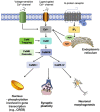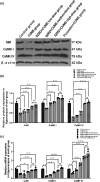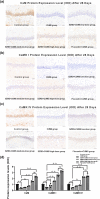Suanzaoren decoction exerts its antidepressant effect via the CaMK signaling pathway
- PMID: 38736723
- PMCID: PMC11087742
- DOI: 10.1515/tnsci-2022-0341
Suanzaoren decoction exerts its antidepressant effect via the CaMK signaling pathway
Abstract
Calmodulin-dependent protein kinases (CaMKs) are widely regarded as "memory molecules" due to their role in controlling numerous neuronal functions in the brain, and the CaMK signaling pathway plays a crucial role in controlling synaptic plasticity. Suanzaoren decoction (SZRD) can improve depression-like behavior and thus has potential benefits in the clinical treatment of depression; however, its mechanism of action is not fully understood. In this study, we found that key proteins in the CaMK signaling pathway were regulated by the decoction used to treat depression. The purpose of this research was to ascertain if the SZRD's therapeutic efficacy in the treatment of depression is associated with the modulation of key proteins in the CaMK signaling pathway. A rat model of depression was created by exposing the animals to chronic, unexpected, mild stress. Model rats were given intragastric administration of SZRD or fluoxetine every morning once a day. Protein and mRNA relative expression levels of CaM, CaMK I, and CaMK IV in the hippocampus were measured by Western blot, quantitative polymerase chain reaction, and immunohistochemistry in the hippocampus. Our findings demonstrated that SZRD significantly improved the mood of depressed rats. This indicates that SZRD, by modulating the CaMK signaling system, may alleviate depressive symptoms and lessen work and life-related pressures.
Keywords: CaMK signaling pathway; Suanzaoren decoction; depression; hippocampus.
© 2024 the author(s), published by De Gruyter.
Conflict of interest statement
Conflict of interest: Authors state no conflict of interest.
Figures






Similar articles
-
SuanZaoRen decoction alleviates neuronal loss, synaptic damage and ferroptosis of AD via activating DJ-1/Nrf2 signaling pathway.J Ethnopharmacol. 2024 Apr 6;323:117679. doi: 10.1016/j.jep.2023.117679. Epub 2023 Dec 29. J Ethnopharmacol. 2024. PMID: 38160863
-
Research on the mechanism of antidepressive effect of Suanzaoren Decoction through TLR4/MyD88/NF-κB pathway and Wnt/β-catenin pathway.J Ethnopharmacol. 2024 Jan 30;319(Pt 1):117190. doi: 10.1016/j.jep.2023.117190. Epub 2023 Sep 20. J Ethnopharmacol. 2024. PMID: 37739105
-
Suanzaoren decoction improves depressive-like behaviors by regulating the microbiota-gut-brain axis via inhibiting TLR4/NFκB/NLRP3 inflammation signal pathway.J Chem Neuroanat. 2023 Dec;134:102349. doi: 10.1016/j.jchemneu.2023.102349. Epub 2023 Oct 23. J Chem Neuroanat. 2023. PMID: 37879571
-
Calmodulin kinases: essential regulators in health and disease.J Neurochem. 2017 Jun;141(6):808-818. doi: 10.1111/jnc.14020. Epub 2017 Apr 17. J Neurochem. 2017. PMID: 28295333 Review.
-
Genetic dissection of corticosterone receptor function in the rat hippocampus.Eur Neuropsychopharmacol. 2001 Dec;11(6):423-30. doi: 10.1016/s0924-977x(01)00119-5. Eur Neuropsychopharmacol. 2001. PMID: 11704419 Review.
Cited by
-
The therapeutic potential of traditional Chinese medicine in depression: focused on the modulation of neuroplasticity.Front Pharmacol. 2024 Aug 26;15:1426769. doi: 10.3389/fphar.2024.1426769. eCollection 2024. Front Pharmacol. 2024. PMID: 39253375 Free PMC article. Review.
References
LinkOut - more resources
Full Text Sources
